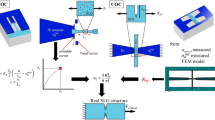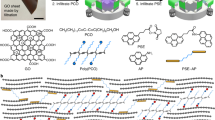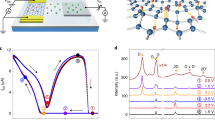Abstract
The extraordinary strength, stiffness1 and lightness of graphene have generated great expectations of its application in flexible electronics and as a mechanical reinforcement agent. However, the presence of lattice defects, unavoidable in sheets obtained by scalable routes, might degrade its mechanical properties2,3. Here we report a systematic study on the elastic modulus and strength of graphene with a controlled density of defects. Counter-intuitively, the in-plane Young’s modulus increases with increasing defect density up to almost twice the initial value for a vacancy content of ∼0.2%. For a higher density of vacancies, the elastic modulus decreases with defect inclusions. The initial increase in Young’s modulus is explained in terms of a dependence of the elastic coefficients on the momentum of flexural modes predicted for two-dimensional membranes4,5. In contrast, the fracture strength decreases with defect density according to standard fracture continuum models. These quantitative structure–property relationships, measured in atmospheric conditions, are of fundamental and technological relevance and provide guidance for applications in which graphene mechanics represents a disruptive improvement.
This is a preview of subscription content, access via your institution
Access options
Subscribe to this journal
Receive 12 print issues and online access
$259.00 per year
only $21.58 per issue
Buy this article
- Purchase on SpringerLink
- Instant access to full article PDF
Prices may be subject to local taxes which are calculated during checkout




Similar content being viewed by others
References
Lee, C., Wei, X. D., Kysar, J. W. & Hone, J. Measurement of the elastic properties and intrinsic strength of monolayer graphene. Science 321, 385–388 (2008).
Gomez-Navarro, C., Burghard, M. & Kern, K. Elastic properties of chemically derived single graphene sheets. Nano Lett. 8, 2045–2049 (2008).
Lee, G-H. et al. High-strength chemical-vapor-deposited graphene and grain boundaries. Science 340, 1073–1076 (2013).
Aronovitz, J. A. & Lubensky, T. C. Fluctuations of solid membranes. Phys. Rev. Lett. 60, 2634–2637 (1988).
Nelson, D., Piran, T. & Weinberg, S. (eds) Statistical Mechanics of Membranes and Surfaces 2nd edn (World Scientific Singapore, 2004).
Huang, P. Y. et al. Grains and grain boundaries in single-layer graphene atomic patchwork quilts. Nature 469, 389–392 (2011).
Ruiz-Vargas, C. S. et al. Softened elastic response and unzipping in chemical vapor deposition graphene membranes. Nano Lett. 11, 2259–2263 (2011).
Fedorov, A. S. et al. DFT investigation of the influence of ordered vacancies on elastic and magnetic properties of graphene and graphene-like SiC and BN structures. Phys. Status Solidi B 249, 2549–2552 (2012).
Georgantzinos, S. K., Katsareas, D. E. & Anifantis, N. K. Limit load analysis of graphene with pinhole defects: A nonlinear structural mechanics approach. Int. J. Mech. Sci. 55, 85–94 (2012).
Jing, N. et al. Effect of defects on Young’s modulus of graphene sheets: A molecular dynamics simulation. Rsc Adv. 2, 9124–9129 (2012).
Katsnelson, M. I. & Fasolino, A. Graphene as a prototype crystalline membrane. Acc. Chem. Res. 46, 97–105 (2013).
Begley, M. R. & Mackin, T. J. Spherical indentation of freestanding circular thin films in the membrane regime. J. Mech. Phys. Solids 52, 2005–2023 (2004).
Bunch, J. S. et al. Electromechanical resonators from graphene sheets. Science 315, 490–493 (2007).
Zandiatashbar, A. et al. Effect of defects on the intrinsic strength and stiffness of graphene. Nature Commun. 5, 3186 (2014).
Krasheninnikov, A. V. & Banhart, F. Engineering of nanostructured carbon materials with electron or ion beams. Nature Mater. 6, 723–733 (2007).
Ugeda, M. M., Brihuega, I., Guinea, F. & Gomez-Rodriguez, J. M. Missing atom as a source of carbon magnetism. Phys. Rev. Lett. 104, 096804 (2010).
Guryel, S. et al. Effect of structural defects and chemical functionalisation on the intrinsic mechanical properties of graphene. Phys. Chem. Chem. Phys. 15, 659–665 (2013).
Kvashnin, A. G., Sorokin, D. G. & Kvashnin, D. G. The theoretical study of mechanical properties of graphene membranes. Fullerenes Nanotubes Carbon Nanostruct. 18, 497–500 (2010).
Neek-Amal, M. & Peeters, F. M. Linear reduction of stiffness and vibration frequencies in defected circular monolayer graphene. Phys. Rev. B 81, 235437 (2010).
Katsnelson, M. I. Graphene: Carbon in Two Dimensions (Cambridge Univ. Press, 2012).
Ghosh, S. et al. Extremely high thermal conductivity of graphene: Prospects for thermal management applications in nanoelectronic circuits. Appl. Phys. Lett. 92, 151911 (2008).
Meyer, J. C. et al. The structure of suspended graphene sheets. Nature 446, 60–63 (2007).
Roldan, R., Fasolino, A., Zakharchenko, K. V. & Katsnelson, M. I. Suppression of anharmonicities in crystalline membranes by external strain. Phys. Rev. B 83, 174104 (2011).
Lucchese, M. M. et al. Quantifying ion-induced defects and Raman relaxation length in graphene. Carbon 48, 1592–1597 (2010).
Vaks, V. G., Katsnelson, M. I., Likhtenstein, A. I., Peschanskikh, G. V. & Trefilov, A. V. Pretransition softening and anomalous pressure-dependence of shear constants in alkali and alkaline-earth metals due to band-structure effects. J. Phys. Condens. Matter 3, 1409–1428 (1991).
Leenaerts, O., Peelaers, H., Hernandez-Nieves, A. D., Partoens, B. & Peeters, F. M. First-principles investigation of graphene fluoride and graphane. Phys. Rev. B 82, 195436 (2010).
Ferrari, A. C. et al. Raman spectrum of graphene and graphene layers. Phys. Rev. Lett. 97, 187401 (2006).
Cancado, L. G. et al. Quantifying defects in graphene via Raman sectroscopy at different excitation energies. Nano Lett. 11, 3190–3196 (2011).
Eckman, A. et al. Probing the nature of defects in graphene by Raman spectroscopy. Nano Lett. 12, 3925–3930 (2012).
Acknowledgements
This work was supported by MAT2013-46753-C2-2-P, Consolider CSD2010-0024, FIS2011-23713 and the European Research Council Advanced Grant, #290846. We acknowledge technical support from A. Aranda, C. Salgado and A. del Campo, and fruitful discussions with M. Jaafar, A. K. Geim, R. Perez, F. Yndurain and J. Soler.
Author information
Authors and Affiliations
Contributions
C.G-N. and J.G-H. devised the experiments. G.L-P. performed the experiments. G.L-P., C.G-N. and J.G-H. analysed the data. F.P-M. prepared the substrates. C.G-N. and J.G-H. wrote the manuscript. V.P., M.I.K. and F.G. formulated the theoretical model. All authors participated in discussions.
Corresponding author
Ethics declarations
Competing interests
The authors declare no competing financial interests.
Supplementary information
Supplementary Information
Supplementary Information (PDF 2087 kb)
Rights and permissions
About this article
Cite this article
López-Polín, G., Gómez-Navarro, C., Parente, V. et al. Increasing the elastic modulus of graphene by controlled defect creation. Nature Phys 11, 26–31 (2015). https://doi.org/10.1038/nphys3183
Received:
Accepted:
Published:
Issue date:
DOI: https://doi.org/10.1038/nphys3183
This article is cited by
-
Anomalous isotope effect on mechanical properties of single atomic layer Boron Nitride
Nature Communications (2023)
-
Mechanics of 2D material bubbles
Nano Research (2023)
-
Data-driven modeling for thermo-elastic properties of vacancy-defective graphene reinforced nanocomposites with its application to functionally graded beams
Engineering with Computers (2023)
-
Ultrastiff graphene
npj 2D Materials and Applications (2021)
-
Possible pair-graphene structures govern the thermodynamic properties of arbitrarily stacked few-layer graphene
Scientific Reports (2021)



